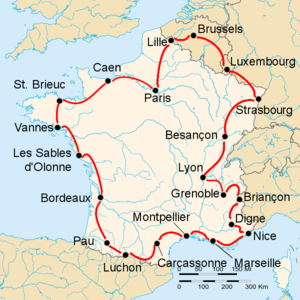1947 Tour de France

Route of the 1947 Tour de France
Followed clockwise, starting and finishing in Paris |
|||||||||||||||||||||||||
| Race details | |||||||||||||||||||||||||
|---|---|---|---|---|---|---|---|---|---|---|---|---|---|---|---|---|---|---|---|---|---|---|---|---|---|
| Dates | 25 June – 20 July | ||||||||||||||||||||||||
| Stages | 21 | ||||||||||||||||||||||||
| Distance | 4,642 km (2,884 mi) | ||||||||||||||||||||||||
| Winning time | 148h 11' 25" | ||||||||||||||||||||||||
| Results | |||||||||||||||||||||||||
|
|||||||||||||||||||||||||
| Winner |
|
(West) | |
| Second |
|
(France) | |
| Third |
|
(Italy) | |
|
|
|||
| Mountains |
|
(Italy) | |
| Team | Italy | ||
The 1947 Tour de France was the 34th edition of the Tour de France, taking place from 25 June to 20 July. The total race distance was 21 stages over 4,642 km (2,884 mi). It was the first Tour since 1939, having been cancelled during World War II, although some Tour de France-like races had been held during World War II.
Because the previous races had been canceled, there was no real favourite for the final victory. When René Vietto, the runner-up of 1939, captured the yellow jersey after his victory on the second stage, many thought he could remain first until the last day. Vietto, a climber, was less optimistic and lost his first place to Italian Pierre Brambilla after the time trial in stage 19. With only two stages to go, many now believed that Brambilla would win the race. On the very last stage, there was an unexpected attack, and little-known French cyclist Jean Robic captured the lead. Robic had won the Tour de France without ever wearing the yellow jersey during the race, the first time that happened. (In 1953 Robic would lead the race for one more day).
After the 1939 Tour de France, the Second World War had made it impossible to organise a big cycling event in France, although some attempts had been taken. The rights on the Tour de France, previously owned by l'Auto, had been transferred to the French government. There were two newspapers interested in taking over these rights, so they both organized cycling events. The event organized by l'Équipe, "La Course du Tour de France", was more successful, and l'Équipe was given the right to organize the 1947 Tour de France.
The national teams format, which had been in use before the Second World War, was used again in 1947. The German team was not invited, and the Italian team was made up out of Franco-Italians living in France, as the peace treaty between France and Italy was not yet official, so the countries were technically still in war. The Tour organisers invited ten teams of ten cyclists each. Besides the Italian team, there was also a French team and a Belgian team, and a combined Swiss/Luxembourgian team. The plan was to have a joint Dutch-British team, but the Dutch cyclists protested because the British cyclists were too inexperienced, and the British cyclists were replaced by "French strangers". There were also five French regional teams: Ile de France, West France, North East France, Center/South West France and South East France.
...
Wikipedia
